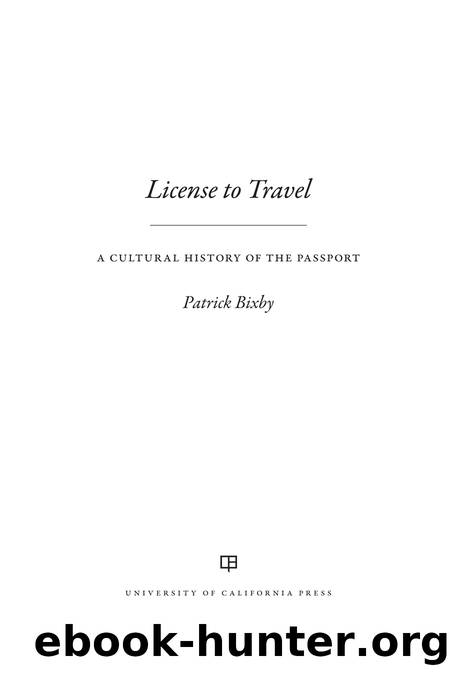License to Travel by Bixby Patrick;

Author:Bixby, Patrick;
Language: eng
Format: epub
Publisher: University of California Press
⢠⢠â¢
If the passport evoked difficult questions regarding personal identity for those travelers and expatriates who left home relatively secure in their national belonging, the documentâs capacity to induce doubts about that communal affiliation was perhaps even stronger. It could also be suggested that, for those marginalized by their societies, the question of national identity is never more pressing than when they are on the move, far beyond the boundaries of their homelands. Langston Hughes acquired his first passport in July 1920, when he was just eighteen years old, in order to visit his father in Mexico, where the older Hughes had relocated in an effort to escape the pervasive racism he had experienced in the United States. Decades after Frederick Douglass had been denied a passport by George M. Dallas, it was still not easy for a Black man or woman in a segregationist America to attain such a document. Hughesâs application required two affidavits, including one signed by his motherâs hand swearing that her son was a ânative citizenâ of the United States by virtue of his birth in Joplin, Missouri. (As was often the case, the attending physician had failed to provide a birth certificate at the time and the city records did not contain documentation for the Black child.) The passport application also contains a striking photograph of the youthful Hughes in a confident head-on pose, dressed in a dark suit and tie, suggestive of his ambition to enroll at Columbia University upon his return to the US. Before that, however, Hughes would compose his first major poem, âThe Negro Speaks of Rivers,â inspired by the view from his train car on his trip south that summer.
The journey to Mexico only stoked his wanderlust, and after Hughes left university early to escape the racism of the faculty and his classmates, he searched for work as a crewman on a merchant ship. Eventually he signed on with an old freighter called the S.S. Malone and, after unceremoniously ditching most of his books in waters off Sandy Hook, departed for a six-month voyage up and down the west coast of Africa. Then, in the spring of 1924, he endured a harrowing crossing from New York to Rotterdam, where he jumped ship and caught a train to Paris, realizing his long-time dream of visiting the city. Soon he found a job in a Montmartre night club and, despite the challenges of living abroad without much money or many contacts, began enjoying the charms of a culture still reemerging after the devastation of the war.
Download
This site does not store any files on its server. We only index and link to content provided by other sites. Please contact the content providers to delete copyright contents if any and email us, we'll remove relevant links or contents immediately.
| Antitrust | Civil Law |
| Emigration & Immigration | Federal Jurisdiction |
| Housing & Urban Development | Indigenous Peoples |
| Land Use | Public |
| Public Contract | Public Utilities |
| Urban, State & Local Government |
Killers of the Flower Moon by David Grann(3753)
Machine Learning at Scale with H2O by Gregory Keys | David Whiting(3648)
Oathbringer (The Stormlight Archive, Book 3) by Brandon Sanderson(2645)
Will by Will Smith(2584)
Once Upon a Broken Heart by Stephanie Garber(2529)
Guns, Germs and Steel by Diamond Jared(2204)
Borders by unknow(2119)
It Starts With Us (It Ends with Us #2) by Colleen Hoover(2048)
The Room Where It Happened by John Bolton;(2034)
Friends, Lovers, and the Big Terrible Thing by Matthew Perry(2008)
The Color of Law by Richard Rothstein(1823)
HBR's 10 Must Reads 2022 by Harvard Business Review(1702)
The Strength In Our Scars by Bianca Sparacino(1700)
A Short History of War by Jeremy Black(1676)
Water Rights and the Environment in the United States by John Burch(1607)
Examples & Explanations: Administrative Law by William F. Funk & Richard H. Seamon(1553)
515945210 by Unknown(1524)
Pharmacy Practice and The Law by Richard Abood(1496)
That Every Man Be Armed by Stephen P. Halbrook(1480)
